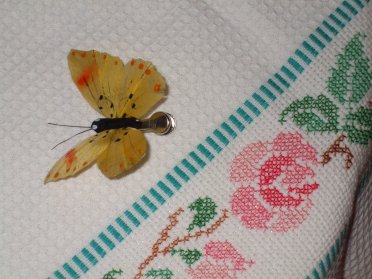Cross-stitch is one of the common and oldest techniques still used. Samplers, pillows, paintings, bookmarks and lots of accessories for the home embroidered in cross-stitch adorn millions of rooms in several countries in the world, this simple technique of embroidery has become a real creative and rewarding pastime for millions and millions of people around the world .

Cross-stitch is one of the embroidery techniques known as counted thread embroidery and it is realized in tissues where you can easily count the wires.
There are tissues with regular weft and warp above which produces embroidery, playing an important role when the work is completed.
Most of counted thread embroidery are relatively simple. The main requirements for this type of embroidery are:
- be able to count the wires,
- interpret a pattern or memorize the motif
- acquire an uniform precision in allstitches
Although tecniques are simple, designs that can be made are sometimes very complex.
Cross-stitch is an embroidery technique used in all the world. It’s very easy to do, it is suitable for drawings or abstract figures, and appears with very precise lines. In small work you can get an effect really purposes and elegant – sometimes with subtle nuances – such as Denmark embroidery with his naturalistic themes.
The cross-stitch technique can also be used to create outdoor areas by the figures. In the West, cross-stitch is also used as a contour stitch. In the Anglo-Saxons countries, you can find cross-stitch in paintings, in the eighteenth century this tradition became the basic stitch for decorative samplers.
The first samplers were simply collections of different points of embroidery, worked on fabrics linen and embroidery from preserved as a model. Following the samplers models were transformed into pieces of furniture and were used in a number of reasons used for curtains. Birds, flowers, trees, houses and patriotic images, such as the American eagle were the reasons most widely used. Embroidery a sampler was part of the girls education.
It could use a wide variety of embroidery stitches in these samplers, but cross-stitch embroidery. was tused very often. In tents were embroidered floral subjects like branches, vases with flowers or other stylized flowers. The images of stylized nature, often becoming unrecognizable, were also embroidered cross-stitch clothes also typical species in many countries of Eastern Europe, Morocco and the Middle East.
In most cross-stitch embroidery the background is not embroidered. This inverts when it’s udes another kind of stitch like Assisi stitch: it’s a style developed in Italy in the sixteenth century. Here the background is worked in cross-stitch, or a variant, and the reasons leave empty.

One thought on “Cross Stitch In The World”